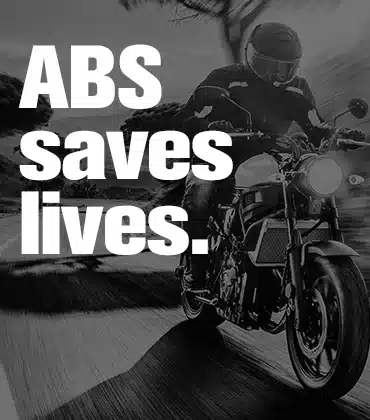Anti-lock braking systems (ABS) have become an increasingly vital safety component in motorcycles over the past few decades.
You may be familiar with the origins of this technology and its value in boosting rider safety.
However, it’s worth exploring a brief history of motorcycle ABS, its concrete benefits, and analyzing why it has become ubiquitous for most manufacturers.
Motorcycle ABS Origins
 Bosch first developed anti-lock brakes for airplanes in the 1920s, but the tech did not make its way to motorcycles until the late 1980s when BMW introduced the first mass-produced bikes equipped with ABS in 1988.
Bosch first developed anti-lock brakes for airplanes in the 1920s, but the tech did not make its way to motorcycles until the late 1980s when BMW introduced the first mass-produced bikes equipped with ABS in 1988.
Even then, it was only available on a handful of models. In the 1990s, other manufacturers like Honda, Triumph, Suzuki, and Yamaha began offering ABS, but usually only on their largest, most expensive touring and sports bikes.
By the early 2000s, smaller displacement bikes were finally getting ABS options as the technology became more compact and cost-effective. It took government safety regulations in Europe in 2016 for ABS to really become standard equipment though.
Today over 80% of new motorcycles have ABS, and nearly all manufacturers offer it as an option if not standard across their model ranges.
It goes without saying that anti-lock brakes dramatically improve braking performance by preventing wheels from locking up. But researching and quantifying those improvements in stopping distances and control has helped highlight the vital role of ABS:
- Shorter stopping distances: multiple studies have shown average decreases of over 25% in braking distances with ABS versus standard brakes. Some tests revealed differences of up to 40%.
- Better control while braking: ABS prevents dangerous loss of stability and control compared to locked wheels. Tests show expert riders can approach but not match ABS performance.
The most significant benefit of ABS is its ability to help riders brake effectively in tricky conditions.
How Does ABS Work?
 ABS works by measuring the speed of the wheels and releasing brake pressure for a split second if a lock-up is detected.
ABS works by measuring the speed of the wheels and releasing brake pressure for a split second if a lock-up is detected.
This pulsating feeling on the pedal or lever can allow the tyres to regain traction and maintain braking force.
The benefits of ABS for motorcycles are many.
an Australian study stated: “ABS was found to enable a greater level of control and stability in braking when compared to the non-ABS system.”
Importance for Motorcycle Safety
While legislation has pushed adoption, the underlying safety benefits that ABS delivers reveal why it has become so ubiquitous and important:
- A 2013 study found a 31% lower fatal crash rate for motorcycles with ABS versus those without it. For context, helmets reduced fatalities by 37% and alcohol increased them by 8% in the same study.
- A 2015 study from the European Road Safety Observatory found ABS reduced fatal accidents by 21% and all accidents by 23%. They estimated widespread use of ABS could save over 1,000 lives in Europe alone.
- Less experienced and aging riders who may have slower reaction times stand to benefit greatly from ABS automatically optimizing their brakes. It provides an extra margin of safety and control.
Specifically in Australia, a study by the Center for Automotive Safety Research found that “the presence of ABS is associated with a statistically significant reduction in the risk of being involved in a casualty crash.”
While ABS technology has progressed greatly, it’s clear that further improvements in rear wheel ABS and combined braking systems can deliver even more gains.
But it is undeniable that anti-lock brakes have become indispensable tools for improving motorcycle safety. For new and even many experienced riders, choosing ABS as standard equipment is arguably just as critical as wearing a quality helmet.
Key Benefits of ABS fitted to Motorcycles
Enhanced Stability and Control:
ABS prevents wheel lock-up during braking, providing riders with enhanced stability and control. This is especially critical in emergency braking situations where maintaining control can be the difference between a near miss and a catastrophic accident.
Reduced Stopping Distances:
Traditional braking systems may lead to wheel lock-up and skidding, increasing stopping distances. ABS optimally modulates brake pressure, allowing for controlled deceleration and shorter stopping distances. Australian research has consistently validated the efficacy of ABS in reducing stopping distances across diverse road conditions.
Improved Maneuverability:
ABS enhances the maneuverability of motorcycles by preventing wheel lock-up and skidding. Riders can make rapid and precise stops without fear of losing control, making ABS particularly beneficial in situations requiring quick evasive maneuvers.
Adaptability to Varied Riding Conditions:
Australia’s diverse geography exposes motorcyclists to a wide range of road conditions, from the arid Outback to wet coastal areas. ABS is designed to adapt to these varying conditions, ensuring consistent braking performance regardless of the terrain. Australian studies emphasize the importance of this adaptability for riders navigating through diverse environments.
Increased Rider Confidence:
ABS instills confidence in riders, particularly those less experienced, by providing a safety net during braking. The assurance that the braking system intervenes when needed without compromising control empowers riders to tackle challenging situations with greater confidence, contributing to overall rider safety.
The Significance of ABS in Australian Motorcycle Safety Research
Reduction in Motorcycle Fatalities:
Australian studies, such as those conducted by the Monash University Accident Research Centre (MUARC), have consistently highlighted the role of ABS in reducing motorcycle fatalities. The ability of ABS to prevent wheel lock-up and maintain control during braking is a key factor in mitigating the severity of accidents.
Impact on High-Side and Low-Side Crashes:
Research conducted by the Australian Road Research Board (ARRB) underscores the importance of ABS in mitigating high-side and low-side crashes. ABS prevents the abrupt loss of traction that can lead to these types of accidents, significantly reducing the risk of injury for motorcyclists.
Integration with Motorcycle Stability Control Systems:
Australian research institutions have been at the forefront of studying the integration of ABS with advanced motorcycle stability control systems. These systems leverage ABS data along with other sensors to enhance overall stability, traction control, and cornering performance, thereby raising the bar for motorcycle safety standards.


